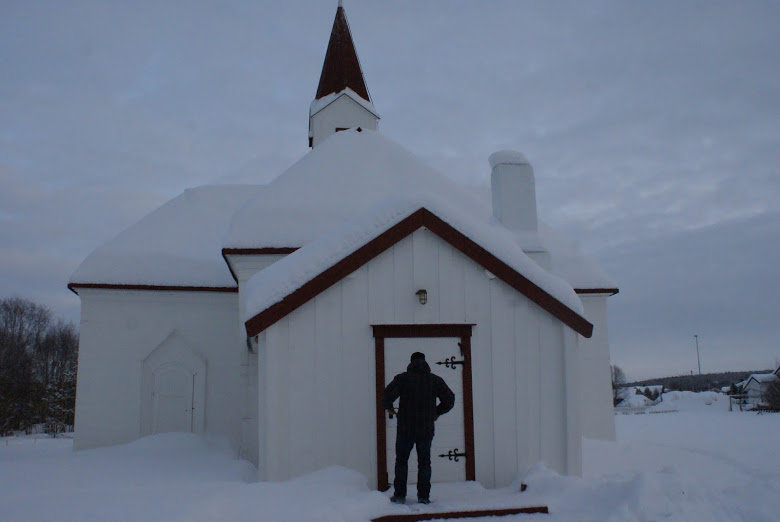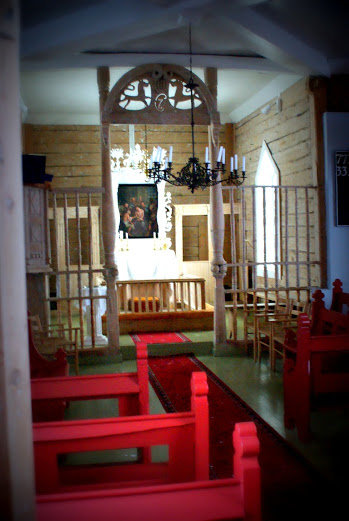The old church in Karasjok is a tiny relic of the old Karasjok, which disappeared during the Second World War.
The old church in Karasjok was built in 1807. It is Finnmark’s oldest Lutheran church; only the small Orthodox St. Georgskapellet in Neiden is older. The church was also the only building to survive the Second World War in the parish of Karasjok. A new and larger church was erected in 1974, but the old one still remains to this day.
The old church has an empire interior
The interior is decorated in the Empire style, the second phase of Neoclassicism, which characterised art during the period. The rood arch is a royal cypher with the letters “C7”, referring to Christian VII, who formally gave the order to build the church. The small pulpit has mirror panels with geometric patterns.
Practical information on the churches of Karasjok
Both churches are located fairly close to one another in central Karasjok on either side of the Karasjoka river that cuts the village in half. If driving the E6 route into Karasjok from the north, take the second exit on the first roundabout following the E6, then at the second roundabout take the first exit on route 92 and you’ll soon see the modern church on your right hand side, then cross the river and you’ll see the old church on the right hand side.
There is no airport in Karasjok, the nearest airport is at Lakselv where many choose to rent a car and make the journey south. Karasjok is also located far from the Norwegian coastline, so boat access is not possible.
The architecture guide for northern Norway and Svalbard has dedicated pages to all architectural sites across the whole region. Information on the old church is separate from the new church, maps, floor plans and more pictures available on the webpage.

The altarpiece was a gift from Tromsø
The altarpiece was a gift from Dean Jens Florup Rasmussen of Tromsø, and is a mirror copy of the Flemish-English artist Van Dyck’s “Christ Crowned with Thorns”. The unknown painter may have used a copper plate as a model. The frame is in white Empire style and rich in detail, but with such a light and flowing line that it is reminiscent of the rococo style. The altarpiece was installed in the church in 1831.
A spire replaced the roof dome
The church has undergone a number of changes since it was built. Today, the tower is a spire, but it was originally dome-shaped. Domes are not particularly common in Norway, but were typical of the Empire style. The church was also originally tarred, but is now painted white on the outside and unpainted on the inside.
The church was a makeshift hospital at the end of the war
In autumn 1944, Karasjok was, like most of Finnmark, burned to the ground and the local people were forced to move out. However, the church was spared. During the spring of 1945, Norwegian forces from England and Sweden advanced into a heavily mined area. On 1 May 1945, a company of soldiers unwittingly entered a minefield. Some 22 of them lost their lives and many more were injured. The church was used as a first-aid post, and a doctor and a nurse from Stockholm parachuted in to help treat the soldiers. Today, there is a memorial of the incident outside Karasjok old church.
Karasjok’s increasing population meant a new church was needed
The old church can only seat 140 people. After the Second World War, Karasjok grew as an urban centre, and the large congregations in the Laestadian parish, big weddings and confirmations meant that the church was no longer big enough. The new church, which can seat 500 people, was therefore opened in 1974.
The new church has proud Sami influences
The shape of the church resembles a lavvu tent with a steep, cone-shaped roof. The nave is octagonal, reflecting the eight seasons of the Sami people. The interior was kept simple at the request of the Laestadians, who dominated church life around the time the church was built. The only decoration is a simple wooden cross and a chandelier. Inside the building, but outside the nave, is the church meeting place. As Karasjok experiences some of the harshest winters in Norway, this meeting place is under cover. Coffee is served here after services.

